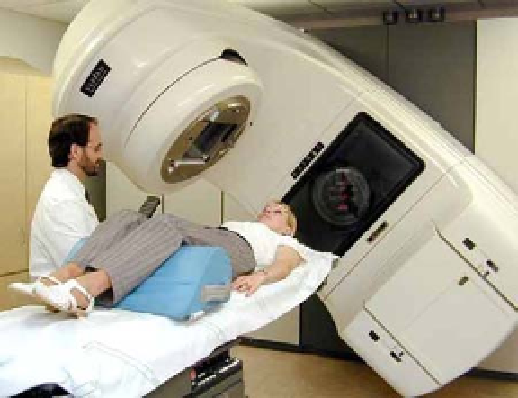Biomedical Engineering Reference
In-Depth Information
FIGURE 15.4
A patient undergoing radiation therapy.
Compliments of http://malignant-mesothelioma-cancer.com/
mesothelioma/wp-content/uploads/2008/02/radiation-therapy.jpg.
step in the fight against cancer. Approximately 50 percent of all diagnosed cancer patients
undergo some form of radiation therapy. Various forms of radiation are implemented,
depending on the depth and size of the targeted area. Unfortunately, radiation will kill both
malignant and healthy tissue, and as such exposure to even lower levels of radiation, while
not showing any apparent effect, will increase the risk of cancer as a long-term effect. It also
increases the probability of genetic defects if the gonads are exposed. This imposes the
need for minimization of radiation exposure to the worker, as well as specific guidelines
for medical applications.
The United States Nuclear Regulatory Commission (NRC) has adopted standards that
limit maximum exposure for the general public to 0.5 sievert (Sv) (Rem) per year. Limits
for occupational exposure are 1.25 Sv/3 mo for the whole body and 18.75 Sv/3 mo for the
extremities. Thus, one of the most important radiation safety procedures is to monitor both
the personnel and the work area. Routine personnel monitoring is usually done with film
badges and ring-type finger badges. Radiation survey and wipe tests are carried out at cer-
tain intervals and at times of incidental/accidental contamination. The common shielding
material is lead, the thickness depending on the energy of gamma rays. Further, radioactive
wastes are stored at assigned areas with appropriate shielding. The procedures used for
radioactive waste disposal depend on the nature and half-life of the waste. All require a
temporary storage facility, and they are finally disposed of locally according to a prescribed
set of procedures.
15.
3 INSTRUMENTATION AND IMAGING DEVIC
ES
From the discussion of radiation measurement it should be clear that radiation energy
can be measured only indirectly—that is, by measuring some effect caused by the radiation.
The following are some of the various indirect techniques used to measure radioactivity:


